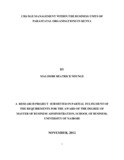| dc.description.abstract | The study focuses on how business units within parastatals in Kenya manage change. The main areas explored include communication of change to employees at all levels, involvement of staff on planning for the change, goals and objectives of change, employees who are affected by change, approval of changes and how the organization manages the various aspects to make sure the change is effectively managed. To achieve this objective a cross-sectional survey study was conducted on various parastatal organizations in Kenya including Kenya Bureau of Standards, Teachers Service Commission, New Kenya Cooperative Creameries, National Bank of Kenya, Kenya Re-Insurance Corporation, National Housing Corporation, Kenya Meat Commission and Kenya National Library Service. The structured questionnaires were randomly administered in all selected parastatals in Kenya. A sample of seven employees from each parastatal were interviewed resulting to total of 48 employees, however only 40 respondents managed to return the questionnaires. Data was collected and the responses coded into labeled categories and keyed into statistical program for social sciences (SPSS) for analysis Since this was a descriptive study, the data obtained was analyzed using statistical tools. Frequency distribution tables, mean scores and standard deviation were used to determine how parastatal organizations in Kenya manage change in their business units. The information was presented by use of frequency tables, charts and graphs. Most of the organization had been operating for more than six years , even the employees had worked for the same organization for more than six years , this means that the data collected is factual. This is an indication that parastatal organizations in Kenya have been operating and managing change. The study shows that Majority of the respondents had worked with the organization for long time thus the data that was collected is valid in terms of experience. It is also notable that in the recent past the organizations have undergone some change due to change in the way business is contacted, new entrants or competitors in the market which has seen the plan change in their business units to remain in existence and in business too. The study was keen to find out the management of change that exists in parastatal organizations in Kenya since this would in a significant way determine how their business units manage change and how effective the management of change can impact on the organization. Management of change has also been faced with various challenges which the
5
organization can devise means of solving or reducing the challenges. It can be said deductively that the management at the top makes the decision in terms of approval of changes in the organization. These changes are implemented by personnel who have little knowledge about the change, basically the line managers are required to cascade the changes to the staff and they are the most affected because they form the link between the top management and the lower level which stands at 59% | en_US |



